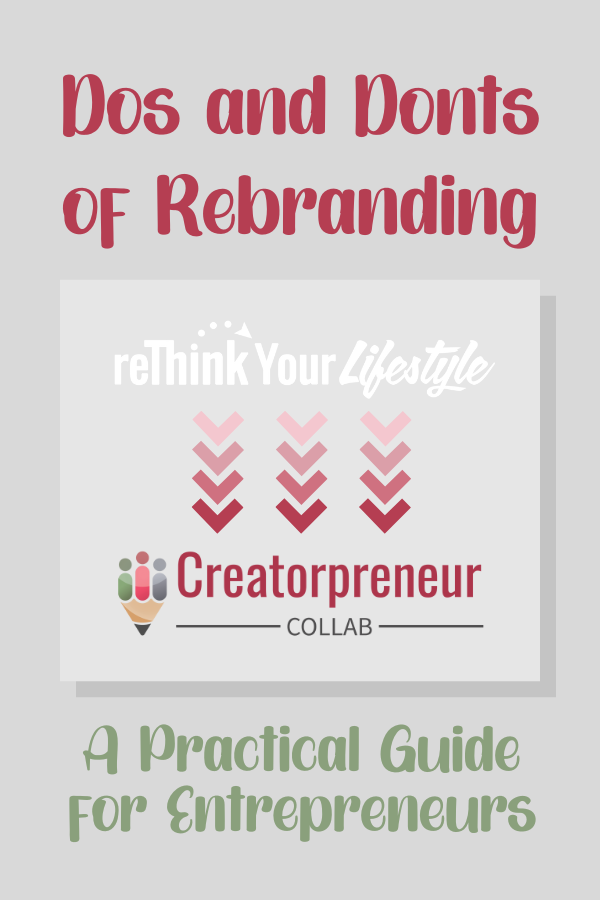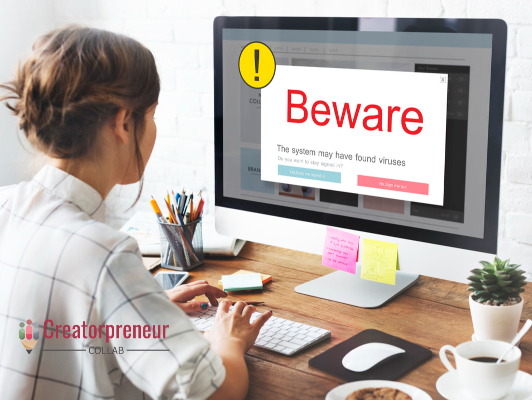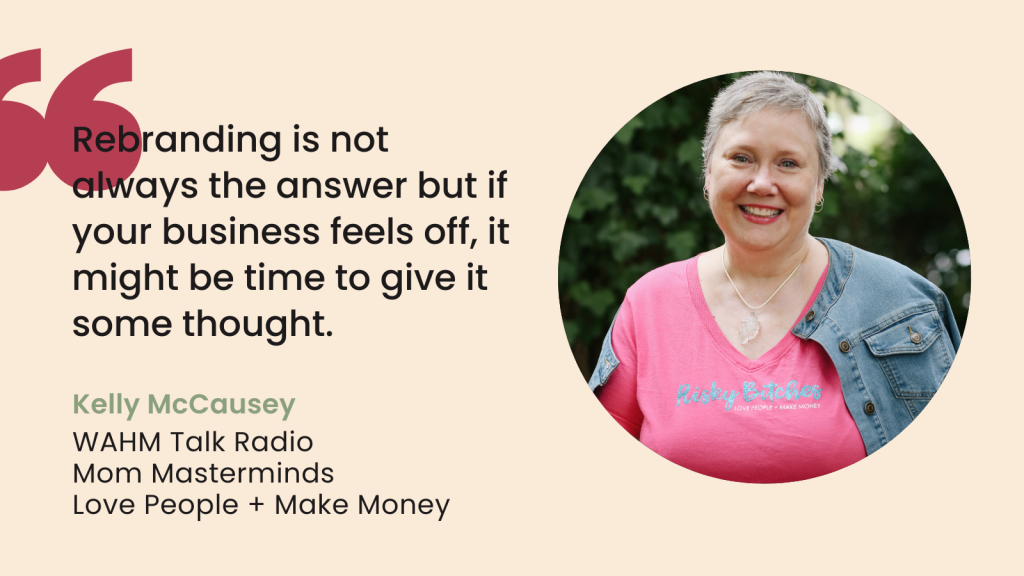
If you're an entrepreneur looking to rebrand your business, there are many factors you need to consider to make your rebranding process successful. Rebranding can be a challenging task that requires careful planning and execution. If you’ve been following me, and especially if you’re a member of my community or email list, then you know I’m in the middle of rebranding my business from reThink Your Lifestyle to Creatorpreneur Collab.
My original plan for my business was to serve the digital learning and online business growth needs of teachers transitioning to owning their own content creation company or side hustle. But after recent changes in our culture, I’ve realized that most teachers who are looking for side gigs or to leave the professional all together are typically looking for jobs. I realized that I needed to shift my focus from teachers to content creators — which can certainly be teachers, but encompasses more people who are specifically focused on creating digital content. These are the people I can both serve and guide with the systems, automation, and coaching they need to succeed.
Before I started this process, which I’ve been pondering and researching for months, I spoke with my own business coach, one of my trusted mentors who has successfully rebranded on line many times. And then I did more research until I found a name that had not been taken and defined the both the audience I want to serve, and the collaborative community I want to create.
So I am now Creatorpreneur Collab — because who doesn’t love a great portmanteau, right? But enough about me. I decided that while this process is still fresh in my mind, I’d write about my journey so you can benefit from it, too. In this practical guide, I’ll walk you through the dos and don'ts of rebranding to ensure you get the best results.
The Importance of Rebranding
Rebranding is a crucial process for businesses that want to stay relevant and competitive in their industries. A brand that doesn't evolve risks becoming outdated and losing its relevance in the market. Rebranding can help you modernize your brand, attract new customers, and differentiate your business from competitors.

Dos of Rebranding
When it comes to rebranding, there are a few dos that you should follow to ensure success.
Define Your Objectives
Before you start the rebranding process, it's important to define your objectives. What do you want to achieve with the rebranding? Do you want to appeal to a new audience, modernize your image, or differentiate yourself from competitors? Defining your objectives will help you create a clear roadmap for your rebranding process and ensure that everyone involved is aligned on the goals.
As I mentioned earlier, I wanted to broaden my audience beyond just those people who are or used to be classroom teachers. The systems, automations, and guidance I provide will help content creators from any background build a successful system grounded in principles of creativity, collaboration, and communication.
Conduct Market Research
Market research is a crucial step in the rebranding process. It helps you understand your customers, competitors, and the industry as a whole. Conducting market research will provide you with valuable insights that will help you make informed decisions throughout the rebranding process.
I’ve spent the past year in groups and forums dedicated to teachers wishing to transition out of the classroom and teachers building a side hustle. Those who were transitioning out into jobs greatly outnumbered those looking for an entrepreneurial venture. And I get it. Even though I have my own business, I’ve also taken on a couple of graduate assistant jobs in order to get the tuition break I need to continue working on my doctorate in English education. Now that I know, thanks to being a part of communities of content creators and communities of educators, I’m shifting my brand to focus on the former.
Communicate with Your Stakeholders
Rebranding can be a sensitive topic, especially for stakeholders like employees, investors, and customers. It's important to communicate openly and transparently with your stakeholders throughout the rebranding process. Keep them informed about the changes and the reasons behind them to avoid confusion and ensure everyone is on board.
As a solopreneur, I don’t have employees or investors. So I’ve focused my communication efforts on my two main communities: My email list and my private Facebook group. These are people who have purchased my products, are friends and family in real life, have been a guest on my podcast, have partnered with me on products, or are entrepreneurs I’ve outsourced ongoing projects to.
The email I sent announcing the rebrand received more feedback in the form of actual replies and encouraging words than any other email I’ve sent the list. I know I’m on the right track!
Develop a Strong Brand Identity
A strong brand identity is essential for a successful rebranding. Your brand identity should reflect your values, mission, and personality. Develop a brand identity that is unique, consistent, and relevant to your target audience.
The most successful way to develop a strong brand identity is to start with understanding your target audience. Find out what they are looking for. The best way to do this is to join their communities and be one of them. Once you know what they’re looking for, you need to think about what you have to offer. This means creating a unique value proposition, and consistently communicating your brand message across all of your channels. It is important to be authentic and transparent in your branding, and to always put your customers first. By following these steps, you can create a brand that is both memorable and meaningful to your customers.
Launch Your Rebrand with a Bang
When it's time to launch your rebrand, make sure you do it with a bang. Create a launch strategy that will generate excitement and buzz around your new brand. Consider hosting an event, creating a social media campaign, or partnering with influencers to promote your rebrand.
Stay tuned to see how I launch my rebrand!
Measure Your Success
Measuring your success is essential to determine whether your rebranding efforts were successful. Set key performance indicators (KPIs) that align with your objectives and track your progress regularly. This will help you make adjustments if necessary and ensure you're on track to achieve your goals.

Don'ts of Rebranding
While there are many things you should do when rebranding your business, there are also some don'ts you should avoid. It's always a good idea to go to a trusted mentor or other experienced person to seek advice before you start a project like this; however, you will still have to travel your own path and will often discover your own "don'ts" along the way. But to help you get started on the best path for you, I'd like to share a few of my own.
Don't Rush the Process
Rebranding is not something you should rush. It requires careful planning and execution. Rushing the process can lead to mistakes, confusion, and a lack of alignment between stakeholders.
Personally, I’m terrible about this. I get a new idea, decide to change direction, and just leap. I’d like to say that as I’ve gotten older, I’ve learned to be more cautious, which is why I’ve been pondering this change for more than a year. I am really glad I waited though because I would not have chosen the rebrand back then that I’m choosing now.
Don't Ignore Your Existing Customers
When rebranding, it's important not to forget about your existing customers. They are the ones who have supported your business so far, and it's important to ensure they remain loyal to your brand. Communicate with them openly about the changes, and make sure they understand the reasons behind them.
This is why I emailed my subscribers and updated my online communities. I will continue to talk about this in upcoming emails and posts for those who might not have seen the others in their busy feeds or who don’t check their email obsessively like someone who I’m not going to name (looking in the mirror here...).
Don't Lose Sight of Your Values
Rebranding can be tempting, but it's important not to lose sight of your values. Your values are what make your brand unique, and they should remain at the core of your rebranding efforts. Make sure your new brand identity is aligned with your values and mission.
In my situation, I think the rebrand is more in line with my values of collaboration, creativity, and entrepreneurship than the old brand. It’s something I’ve known for awhile as I’ve refined both who I am as a creator and entrepreneur and as I’ve spent time learning about my customers. For those of us who are teachers, it’s been like walking into a English language arts class at the beginning of the year with a plan in mind and then after a few weeks of getting to know your students, realizing that none of the material you’ve planned is going to work. You’re going to have to start all over with that class to find books and writing assignments they’ll actually care about and what to engage with — but still keeping your values as a teacher.
Don't Neglect Your Brand Equity
Brand equity is the value that your brand adds to your business. It's built over time through customer loyalty, reputation, and brand recognition. When rebranding, it's important not to neglect your brand equity. Consider how the changes will impact your existing brand equity and find ways to preserve it.
The most important ways to preserve your brand equity include remembering that rebranding takes time. Don't expect your new brand to be a overnight success. It takes time for customers to learn about your new brand and to start associating it with your products or services. You’ll need to be consistent, maintain communication, and be patient.
Don't Copy Competitors
Rebranding is an opportunity to differentiate yourself from competitors, not to copy them. Your brand should be unique, relevant, and authentic. Don't try to mimic the branding of competitors, or you risk becoming indistinguishable from them.
One of the best ways to avoid copying your competitors, once you’ve done your market research, is to focus on your strengths. What makes your business unique? What are you good at? When you rebrand, focus on highlighting your strengths and differentiating yourself from your competitors. This means don't be afraid to be different. If you want to stand out from the crowd, you’ll have to be different. Go for a bold new look or a unique marketing strategy. Just make sure it's something that your target audience will appreciate.
Don't Overspend
Rebranding can be costly, but it doesn't have to break the bank. Set a budget for your rebranding efforts and stick to it. Prioritize the changes that will have the most impact and find creative solutions to keep costs down.
I recommend making a list of all the changes you’ll need to make — everything from your logo to your email addresses, printed business cards, printables, and watermarks. Do as much as you know how to do yourself, but also know when to hire someone else.
In my case, I am handling the web design and logo changes, but hired out the revising my podcast intros and outros. I also decided that my old shows will stay the same, and the new branding will go into effect with the new episodes.
Creatorpreneur Insights
While I have rebranding my businesses a few times over the past 20 years as I worked to improve my communications with the people I serve, I also know it’s important to listen to people with even more experience and even more success. So naturally, I thought about my trusted mentors and other creative entrepreneurs who’ve traveled similar journeys under their tutelage. So I asked a handful of experts to share their insights into rebranding their businesses.
Kelly McCausey of Love People + Make Money
Kelly started out online as the host of WAHM Talk Radio and later built the Mom Masterminds brand along side it. A few years ago though, she rebranded her online presence to Love People & Make Money, which epitomizes what she does. I reached out and asked for her input in this article, and this is what she had to say.

Rebranding a business is exciting. It's tough too - and deeply personal for most entrepreneurs. Suggesting someone change a business name can spark resistance - but over the years I've had the conversation many times.
When a brand feels off, I see the owner struggle to move forward. If a brand is outright confusing, their target market will say no to something they might otherwise really want to say yes to.
I'm no branding expert, but like most, I have opinions. I fully acknowledge that my opinion can be wrong too. Some brands I've disliked have been hugely successful and some I've loved have failed miserably. We might want to admit, branding is art more than a science. Art is subjective and branding is in the eye of the beholder 😉
For online business owners, I think a common mistake is thinking that a rebrand is only about getting a new domain name and logo. Branding is so much more than that. It's about who you are, how you show up, how you express yourself. It's about who you serve, what they need and how you will connect with them. It's about voice, graphics and community culture too.
Still, online - the domain name and logo are where it starts and you don't want to have a stinker.
I quite enjoy the opportunity to brainstorm new domain names. It feels good to support a creator as they choose a direction for their brand that fits like a glove and connects well with the people they want to serve.
Rebranding is not always the answer but if your business feels off, it might be time to give it some thought. Shake the etch-a-sketch and try on some new ideas for size.
Learn more about Kelly's Love People + Make Money resources.
Alice Seba of EKit Hub
Alice is one of the first highly successful work at home mom entrepreneurs I became aware of and wanted to be like when I first started out online back in the early 2000s. She created a community at Internet-Based Moms, served as a freelance copywriter, and sponsored Kelly’s WAHM Talk Radio. She started Internet Marketing Sweetie from which I learned about working collaboratively with my competitors and serving my customers instead of competing and selling.

I think it's an honour that you asked me to speak to this topic, which means it must look like I'm doing something right. And I say "look like" because when it comes to branding, it's really not something I'd consider myself an expert at all. That said, I have rebranded myself successfully many times over in my 21 year entrepreneurial career.
All in all, I think the most important thing to remember is that while many online business fundamentals stay the same...the market doesn't. The market's tastes and needs definitely change over time and you have to pay attention to that.
Those changes can be based on what's fashionable, new technology, current wisdom or any other number of things that vary niche to niche. The key is to be paying attention and be ready to pivot before it is a detriment to your business.
Pay attention by listening to your customers, tracking their buying habits and watching the market in general. You will see where things are going if you're aware, you'll be able to implement small changes to see how your customers respond and see if you should build on that with an overall brand change.
Most importantly, trust your instincts. To me, rebranding is more about instinct, capitalizing on opportunities and catering to my customers than it is crafting just the right image.
Learn more about Alice's EKit Hub resources.
Angela Wills of Living Lifestyle Freedom
I first met Angela in Kelly’s Mom Masterminds group back in the early 2000s when she started her self-named virtual assistant business, which she rebranded to Business Marketing Mojo, then Marketers Mojo, which morphed into Laptop Lifestyle and now Living Lifestyle Freedom as her focus changed over time. With lots of experience with rebranding, Angela has a unique perspective.

So my biggest piece of advice is to make sure you are not rebranding because you're bored or because you think you need to change your whole business name and look to increase your income. I've made this mistake a time or two before and it actually hurts rather than helps. When you establish a brand you create a comfortable trust with your community so rebranding should not be taken lightly. Sometimes a brand just isn't a fit and that's a good time to rebrand, or when your expertise or focus has shifted. Otherwise if it's about boredom or growth there are so many things you can do within your existing brand without having to work to re-establish a new brand.
Other than that I could say that there is so much more to a brand than the name, the color or the logos. To me a brand is about the FEELING you give your customers as well as the core values you represent through your brand. No matter what you rename your business to if your core values and messages remain consistent then you can easily have those customers come along with you to the new brand... they'll still feel connected to you and your business because they know what you stand for.
That's the best advice I can think of at the moment. I'm not much of a planner and so my brand changes happen kind of naturally or even randomly.
Learn more about Angela at Living Lifestyle Freedom.
Food for Thought
Rebranding is a significant undertaking that requires careful planning and execution. By following the dos and avoiding the don'ts, you can ensure a successful rebranding process that will modernize your brand, attract new customers, and differentiate your business from competitors. Remember to communicate openly with your stakeholders, preserve your brand equity, and measure your success.
FAQ
Rebranding should be done strategically and not on a set timeline. If your business has outgrown its current brand or needs to modernize its image, rebranding may be necessary. However, it's important not to rebrand too often, as it can confuse customers and erode brand equity.
The length of the rebranding process depends on the scope of the changes and the size of the business. It can take anywhere from a few months to a year or more.
Choosing a new brand name should involve research and brainstorming. Consider the values and personality of your business, your target audience, and the competitive landscape. You may also consider contacting a business coach for content creators for a strategy session or invest in Kelly's Banner Message Training.
Communicate a rebrand to customers through various channels, including social media, email, and your blog. Be transparent about the changes and the reasons behind them.
Set key performance indicators (KPIs) that align with your objectives and track your progress regularly. This will help you determine whether your rebranding efforts were successful.
Common rebranding mistakes to avoid include rushing the process, neglecting your existing customers, losing sight of your values, neglecting your brand equity, copying competitors, and overspending.
This is a great question and merits its own blog post. But my best advice is to make sure you do you due diligence in creating your brand in the beginning, rebrand only when your market demands it, and then give yourself a lot of creative outlets such as creating new courses, digital products, etc. under the umbrella of your brand. This way your new products benefit from your brand equity, but also give you an outlet for your creativity. If you're struggling with this, check out Kelly's Ideas in Order training.
Need rebranding content for your website?

Whether you're writing for your own audience of business owners or a coach serving clients who might need to rebrand your their businesses, you need a quick and easy way to develop the materials you need without having to write everything yourself.
Learn more about the private label rights pack my friends at White Label Perks created, including:
Since this pack is PLR, you can use all of these resources on your website, in your social media channels, and as part of your coaching processes with clients. Click here to learn more!
Considering rebranding your business but not sure where to start?
Setup a Strategy Call with Michelle

